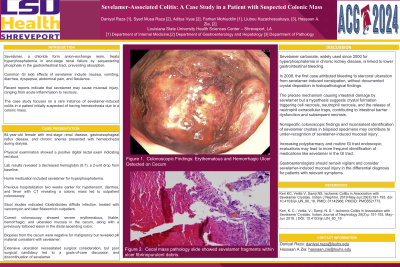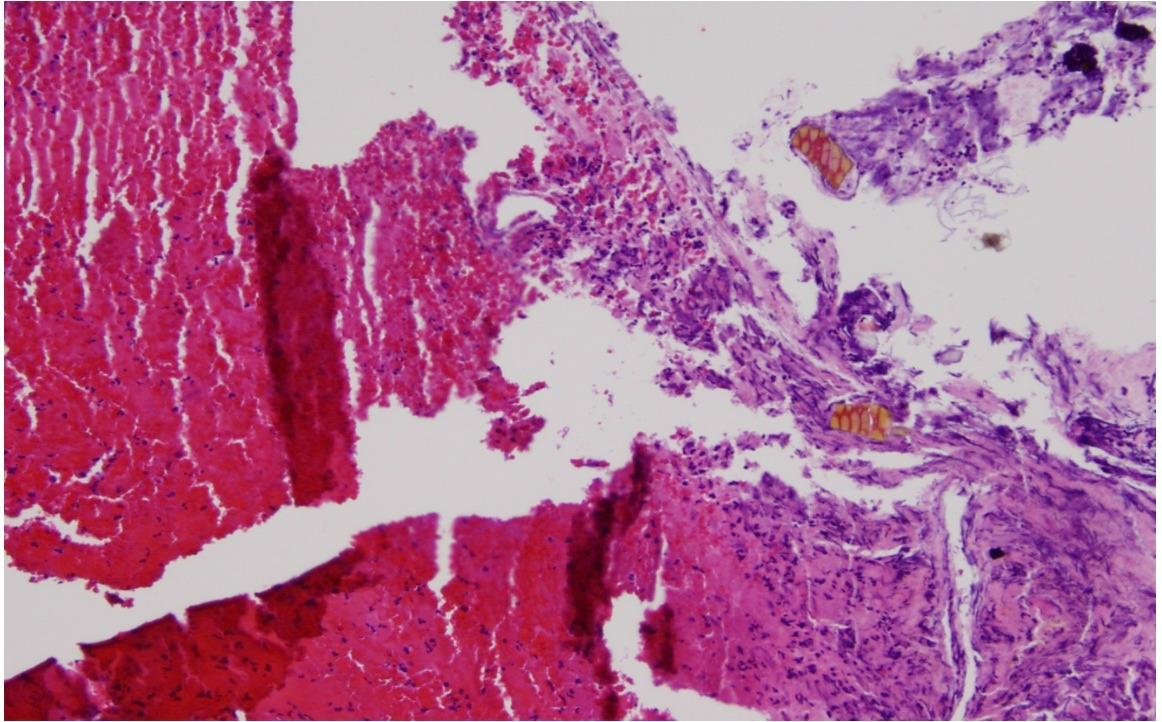Sunday Poster Session
Category: Colon
P0312 - Sevelamer-Associated Colitis: A Case Study in a Patient With Suspected Colonic Mass
Sunday, October 27, 2024
3:30 PM - 7:00 PM ET
Location: Exhibit Hall E

Has Audio

Daniyal Raza, MD
LSU Health
Shreveport, LA
Presenting Author(s)
Daniyal Raza, MD1, Farhan Mohiuddin, MD2, Syed Musa Raza, MD1, Aditya Vyas, MD1, Liubou Kazachesuskaya, MD1, Hassaan A. Zia, MD1
1LSU Health, Shreveport, LA; 2LSU Health, New Orleans, LA
Introduction: Sevelamer, a basic anion-exchange resin in chloride form, is used to treat hyperphosphatemia in end-stage renal failure patients by sequestering phosphate in the gastrointestinal (GI) tract, preventing absorption. Common GI side effects include nausea, vomiting, diarrhea, dyspepsia, abdominal pain, and flatulence. This case study explores a rare instance of sevelamer-induced colitis in a patient initially suspected of having hematochezia due to colonic mass.
Case Description/Methods: An 84-year-old female with a history of end-stage renal disease, gastroesophageal reflux disease, and chronic anemia presented with hematochezia during dialysis. The physical examination was unremarkable, except for a positive digital rectal exam indicating red stool. Lab results showed a decreased hemoglobin of 8.7, a drop of 2 units from her baseline. The patient's home medication included sevelamer for hyperphosphatemia. Notably, she had been hospitalized two weeks earlier for hypotension, diarrhea, and fever, with a computed tomography (CT) scan revealing a colonic mass, prompting an outpatient colonoscopy. Colonoscopy during this admission revealed severe erythematous, friable, hemorrhagic, and ulcerated mucosa in the cecum, as well as a previously tattooed lesion in the distal ascending colon (Figure 1). Biopsies from the cecum were negative for malignancy but revealed multiple fragments of pill material consistent with sevelamer (Figure 2). The extent of ulceration necessitated surgical intervention; however, due to the patient's poor surgical candidacy, a goals-of-care discussion ensued with the family, leading to the discontinuation of sevelamer.
Discussion: Sevelamer carbonate has been used to treat hyperphosphatemia in chronic kidney disease since 2000. The mechanism by which sevelamer causes intestinal damage is unclear, but one hypothesis suggests that crystal formation by sevelamer triggers cell necrosis and neutrophil activation, leading to intestinal barrier dysfunction and necrosis. Under-recognition of sevelamer-induced mucosal injury may be due to the rarity of severe cases, nonspecific colonoscopic findings, subtle or absent histopathologic features, and inconsistent identification of sevelamer crystals in biopsies. Gastroenterologists should consider sevelamer-induced mucosal injury in their differential diagnosis for patients with relevant symptoms.

Disclosures:
Daniyal Raza, MD1, Farhan Mohiuddin, MD2, Syed Musa Raza, MD1, Aditya Vyas, MD1, Liubou Kazachesuskaya, MD1, Hassaan A. Zia, MD1. P0312 - Sevelamer-Associated Colitis: A Case Study in a Patient With Suspected Colonic Mass, ACG 2024 Annual Scientific Meeting Abstracts. Philadelphia, PA: American College of Gastroenterology.
1LSU Health, Shreveport, LA; 2LSU Health, New Orleans, LA
Introduction: Sevelamer, a basic anion-exchange resin in chloride form, is used to treat hyperphosphatemia in end-stage renal failure patients by sequestering phosphate in the gastrointestinal (GI) tract, preventing absorption. Common GI side effects include nausea, vomiting, diarrhea, dyspepsia, abdominal pain, and flatulence. This case study explores a rare instance of sevelamer-induced colitis in a patient initially suspected of having hematochezia due to colonic mass.
Case Description/Methods: An 84-year-old female with a history of end-stage renal disease, gastroesophageal reflux disease, and chronic anemia presented with hematochezia during dialysis. The physical examination was unremarkable, except for a positive digital rectal exam indicating red stool. Lab results showed a decreased hemoglobin of 8.7, a drop of 2 units from her baseline. The patient's home medication included sevelamer for hyperphosphatemia. Notably, she had been hospitalized two weeks earlier for hypotension, diarrhea, and fever, with a computed tomography (CT) scan revealing a colonic mass, prompting an outpatient colonoscopy. Colonoscopy during this admission revealed severe erythematous, friable, hemorrhagic, and ulcerated mucosa in the cecum, as well as a previously tattooed lesion in the distal ascending colon (Figure 1). Biopsies from the cecum were negative for malignancy but revealed multiple fragments of pill material consistent with sevelamer (Figure 2). The extent of ulceration necessitated surgical intervention; however, due to the patient's poor surgical candidacy, a goals-of-care discussion ensued with the family, leading to the discontinuation of sevelamer.
Discussion: Sevelamer carbonate has been used to treat hyperphosphatemia in chronic kidney disease since 2000. The mechanism by which sevelamer causes intestinal damage is unclear, but one hypothesis suggests that crystal formation by sevelamer triggers cell necrosis and neutrophil activation, leading to intestinal barrier dysfunction and necrosis. Under-recognition of sevelamer-induced mucosal injury may be due to the rarity of severe cases, nonspecific colonoscopic findings, subtle or absent histopathologic features, and inconsistent identification of sevelamer crystals in biopsies. Gastroenterologists should consider sevelamer-induced mucosal injury in their differential diagnosis for patients with relevant symptoms.

Figure: Biopsy of the cecal mass revealed fragments of pill material consistent with sevelamer, which were found within the ulcer fibrinopurulent debris.
Disclosures:
Daniyal Raza indicated no relevant financial relationships.
Farhan Mohiuddin indicated no relevant financial relationships.
Syed Musa Raza indicated no relevant financial relationships.
Aditya Vyas indicated no relevant financial relationships.
Liubou Kazachesuskaya indicated no relevant financial relationships.
Hassaan A. Zia indicated no relevant financial relationships.
Daniyal Raza, MD1, Farhan Mohiuddin, MD2, Syed Musa Raza, MD1, Aditya Vyas, MD1, Liubou Kazachesuskaya, MD1, Hassaan A. Zia, MD1. P0312 - Sevelamer-Associated Colitis: A Case Study in a Patient With Suspected Colonic Mass, ACG 2024 Annual Scientific Meeting Abstracts. Philadelphia, PA: American College of Gastroenterology.
